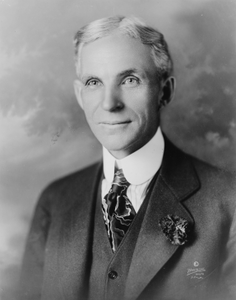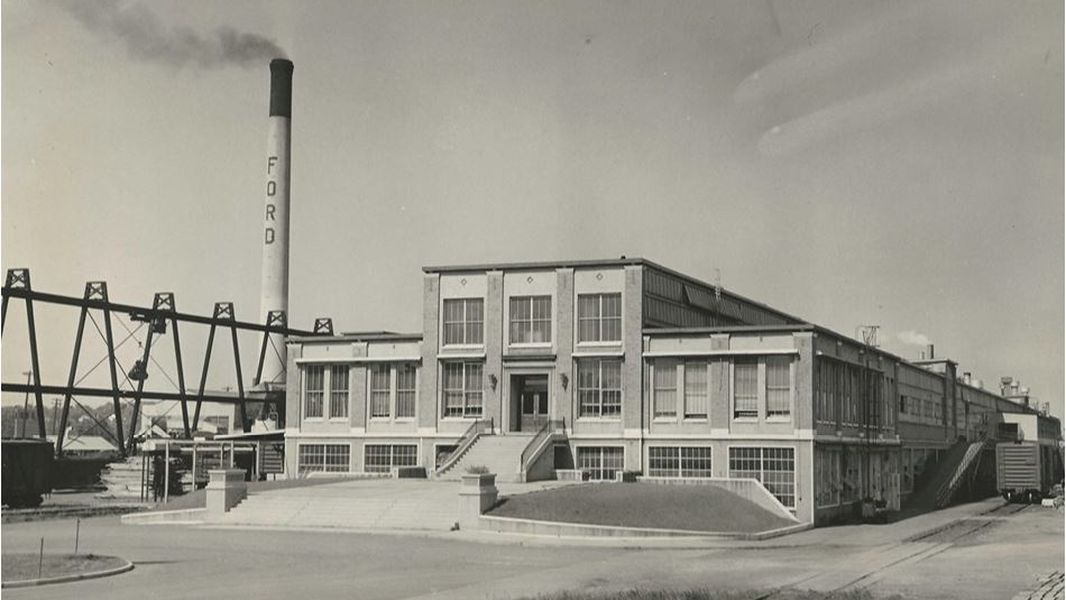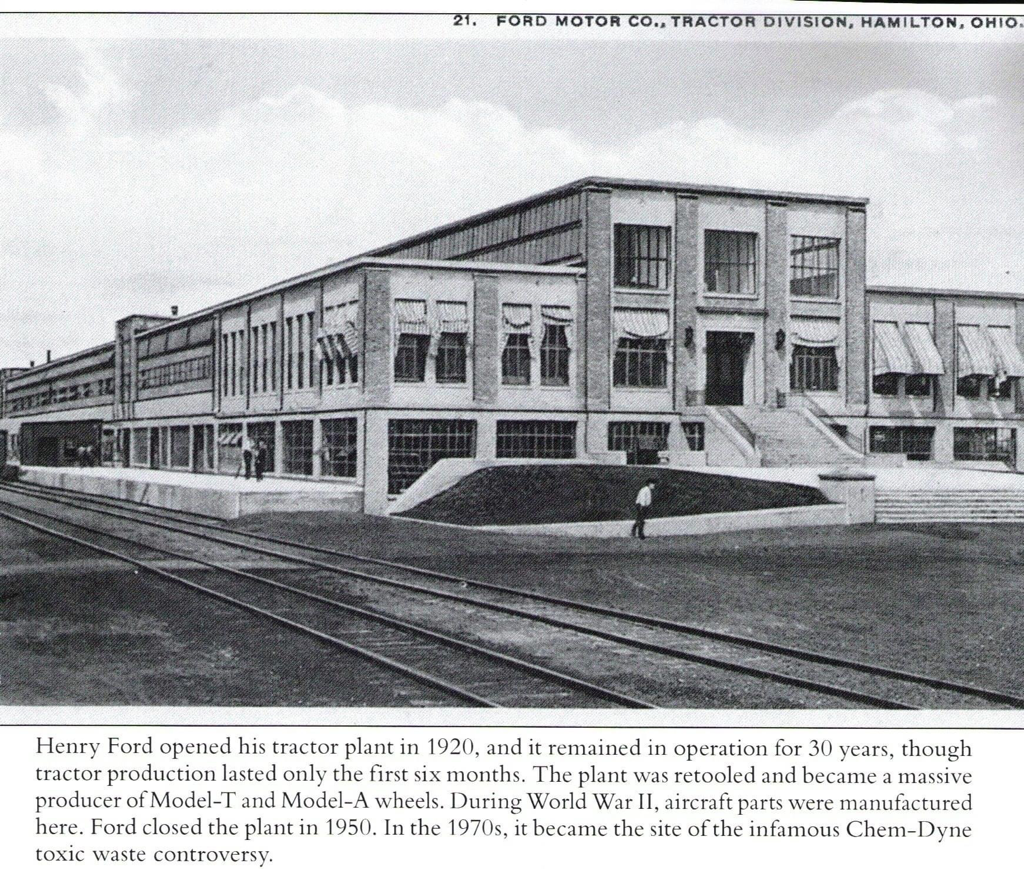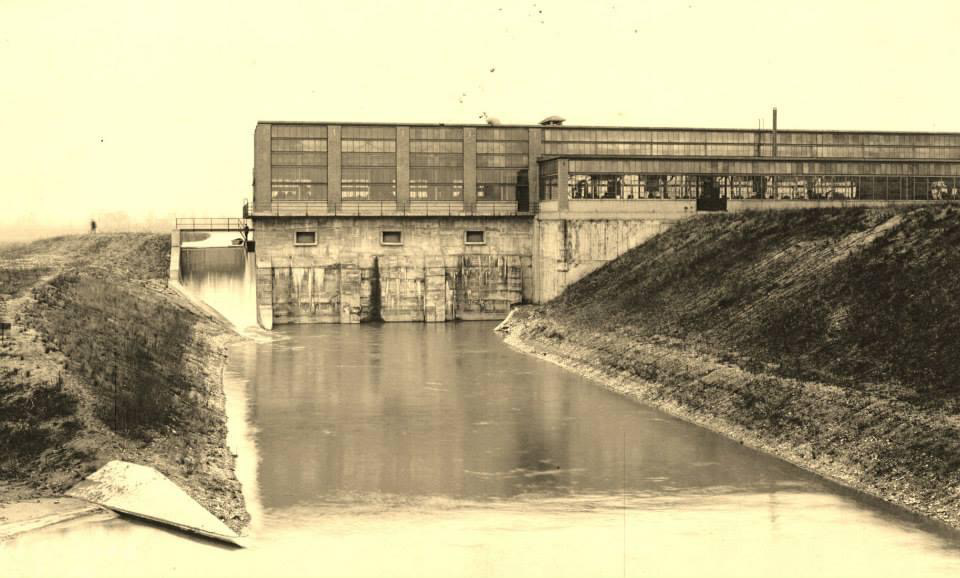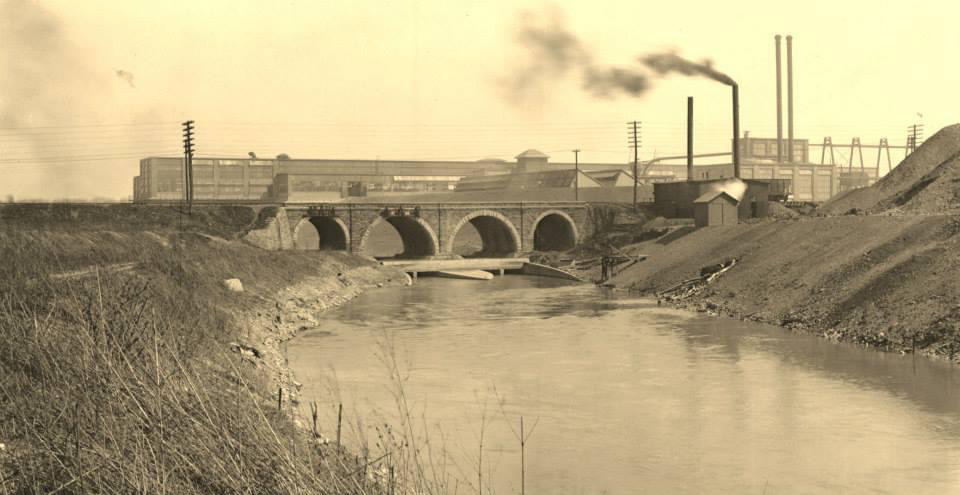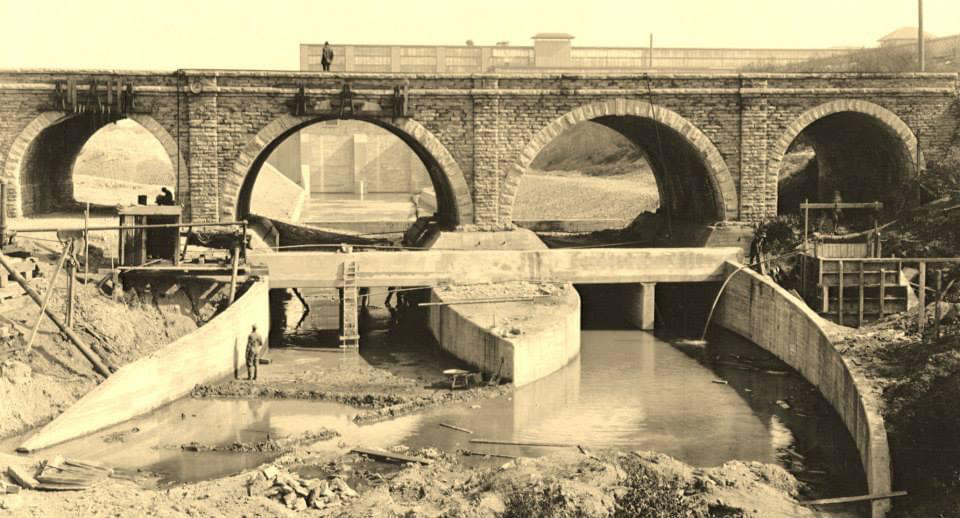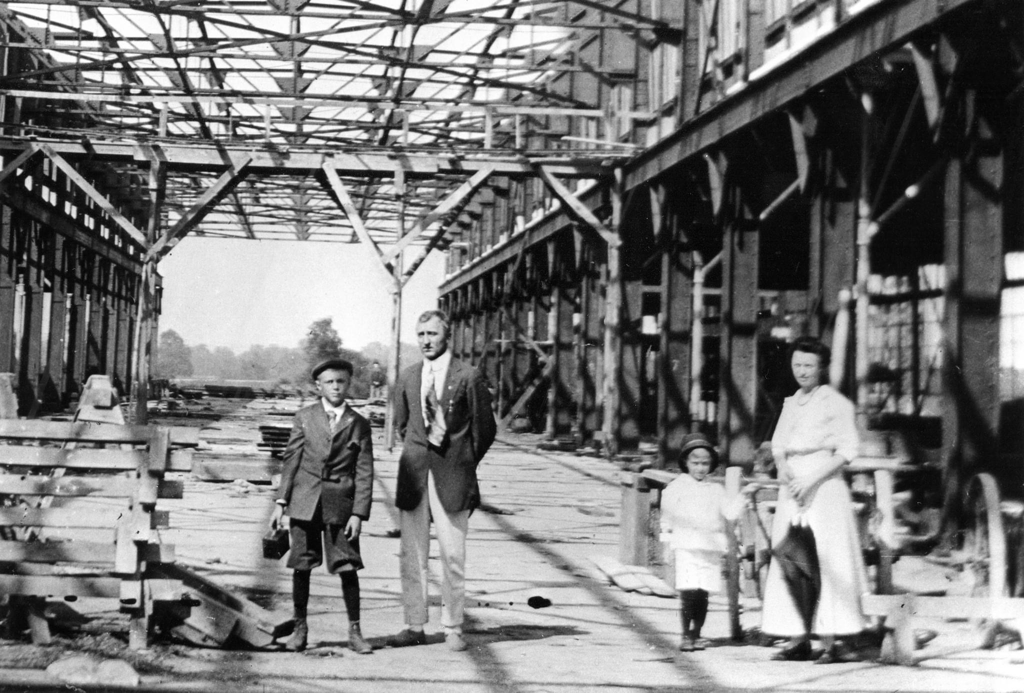Ford Tractor Plant
|
Above: Site of the Ford Plant, Hamilton, Ohio, as it was being built, ca. 1918. From left to right: Boy with camera - Alfred Fritzche, Jr.; Father next to him - Alfred Fritzsche, Sr.; Small boy - Oscar H, Fritzsche; and Mother - Bertha Fritzsche. The Fritzsche family lived at 308 Edison Avenue in Hamilton. From the George C. Cummins “Remember When” Photograph Collection. Donated by the family of George C. Cummins. Photo used courtesy of the George C. Cummins "Remember When" Collection at the Hamilton Lane Library, Hamilton, Ohio.
|
Ninety years ago, residents of the Hamilton area were anticipating the opening of a new industry, one that promised job opportunities and a major boost for the local economy, including increased demand for new housing. Intensifying the excitement was the familiar entrepreneur responsible for building the factory.
Henry Ford’s name was synonymous with the automobile in 1920. But his Hamilton venture – in cooperation with his son, Edsel Ford – wasn’t formed to build cars. It wasn’t a part of the Ford Motor Co. Itwas incorporated separately to produce gasoline-powered tractors.
When the plant on the north edge of Hamilton opened in April 1920, Henry Ford & Son Co. manufactured Fordson tractors. Priced at about $700 each, the Fordson was expected to become as popular amongfarmers as Ford’s model T was in the automotive market.
Henry Ford announced his intent to build the Hamilton plant July 12, 1918, four months before an armistice ended World War I in Europe. Construction began in May 1919 on a small part of the hundreds of acres Ford had purchased at the end of N. Fifth Street.
Ford also was known as an innovator, and that reputation was evident as he planned his Hamilton tractor factory.
August 16, 1918, a little more than a month after revealing he would build the local plant, the New York Times disclosed some of Ford’s vision for future developments, starting in Hamilton.
"Henry Ford is preparing to spend millions of dollars in developing the water power of the United States," the Times reported. "A $2 million tractor plant in Hamilton, Ohio, to be operated by water power, will be the first link in the big chain." (Allowing for inflation, $2 million in 1920 would exceed $20.5 million today.)
The unnamed writer said "before the plan is complete, Mr. Ford will have several tractor factories operated by water in various parts of the country. He believes that by establishing this method of manufacturing he will make it necessary for workingmen to come to the larger cities."
Ford’s interest in producing an affordable gas-powered tractor has been traced to his youth when he worked on his father’s farm in Michigan. He hated the hard work. A biographer said Ford wanted to bring "to the farms the power that could do away with the drudgery and perhaps make farming a congenial occupation."
Before entering the auto business, Ford spent about two years trying to develop a better steam-powered tractor. He concluded a boiler required such a large vehicle that an affordable tractor couldn’t be built using steam.
The 1918 Times article said "Mr. Ford has always wanted to advance the agricultural conditions of the world so that they would keep pace with those of manufacturing and transportation. He believes that he has made a step toward solving the problem of making the life of the farmer one that combines advantages of both country and city and making him industrious and contented during all seasons of the year."
Ford told the Times "it is our idea to develop the water power of small streams in the communities where they are located and not transmit the power over long distances." In Hamilton he hoped to utilize the Great Miami River "to operate a plant which will turn out 300 tractors a day."
"In the winter," Ford said, "when the water power is greatest, the plant will be run at full capacity, and during two or three months of the summer, when the streams dry up, some few employees will remain in the plant for melting steel by electricity. The greater number of employees, however, will be able to go back to their farms or help their neighbors with the harvests. It will give them a vacation that will be both healthful and beneficial."
It was obvious Ford intended to have farmers produce his tractors.
Before the Hamilton plant opened, a local newspaper said "it is the belief that with the farmer building the machine which does most of his work on the farm, that it will create a greater interest on the farm and thereby make better citizens."
Hamilton may have been the first Ford tractor plant using water power, but an auto parts factory was built at the same time in Northville, Michigan, utilizing the Rouge River. In the next 20 years, Ford built 30 hydro-powered facilities in Michigan, Ohio, New York and Mississippi.
Henry Ford’s name was synonymous with the automobile in 1920. But his Hamilton venture – in cooperation with his son, Edsel Ford – wasn’t formed to build cars. It wasn’t a part of the Ford Motor Co. Itwas incorporated separately to produce gasoline-powered tractors.
When the plant on the north edge of Hamilton opened in April 1920, Henry Ford & Son Co. manufactured Fordson tractors. Priced at about $700 each, the Fordson was expected to become as popular amongfarmers as Ford’s model T was in the automotive market.
Henry Ford announced his intent to build the Hamilton plant July 12, 1918, four months before an armistice ended World War I in Europe. Construction began in May 1919 on a small part of the hundreds of acres Ford had purchased at the end of N. Fifth Street.
Ford also was known as an innovator, and that reputation was evident as he planned his Hamilton tractor factory.
August 16, 1918, a little more than a month after revealing he would build the local plant, the New York Times disclosed some of Ford’s vision for future developments, starting in Hamilton.
"Henry Ford is preparing to spend millions of dollars in developing the water power of the United States," the Times reported. "A $2 million tractor plant in Hamilton, Ohio, to be operated by water power, will be the first link in the big chain." (Allowing for inflation, $2 million in 1920 would exceed $20.5 million today.)
The unnamed writer said "before the plan is complete, Mr. Ford will have several tractor factories operated by water in various parts of the country. He believes that by establishing this method of manufacturing he will make it necessary for workingmen to come to the larger cities."
Ford’s interest in producing an affordable gas-powered tractor has been traced to his youth when he worked on his father’s farm in Michigan. He hated the hard work. A biographer said Ford wanted to bring "to the farms the power that could do away with the drudgery and perhaps make farming a congenial occupation."
Before entering the auto business, Ford spent about two years trying to develop a better steam-powered tractor. He concluded a boiler required such a large vehicle that an affordable tractor couldn’t be built using steam.
The 1918 Times article said "Mr. Ford has always wanted to advance the agricultural conditions of the world so that they would keep pace with those of manufacturing and transportation. He believes that he has made a step toward solving the problem of making the life of the farmer one that combines advantages of both country and city and making him industrious and contented during all seasons of the year."
Ford told the Times "it is our idea to develop the water power of small streams in the communities where they are located and not transmit the power over long distances." In Hamilton he hoped to utilize the Great Miami River "to operate a plant which will turn out 300 tractors a day."
"In the winter," Ford said, "when the water power is greatest, the plant will be run at full capacity, and during two or three months of the summer, when the streams dry up, some few employees will remain in the plant for melting steel by electricity. The greater number of employees, however, will be able to go back to their farms or help their neighbors with the harvests. It will give them a vacation that will be both healthful and beneficial."
It was obvious Ford intended to have farmers produce his tractors.
Before the Hamilton plant opened, a local newspaper said "it is the belief that with the farmer building the machine which does most of his work on the farm, that it will create a greater interest on the farm and thereby make better citizens."
Hamilton may have been the first Ford tractor plant using water power, but an auto parts factory was built at the same time in Northville, Michigan, utilizing the Rouge River. In the next 20 years, Ford built 30 hydro-powered facilities in Michigan, Ohio, New York and Mississippi.
Ford’s Airport
Mention Henry Ford and the name suggests a man who had a tremendous impact on the infant automobile industry, including a plant his company opened in Hamilton in 1920. But Ford also is in the National Aviation Hall of Fame in Dayton, and his varied flying ventures included operation of an airport in Hamilton in the 1920s.
Ford biographers note that Ford founded the Ford Motor Company in 1903, the same year the Wright brothers made the first controlled, powered flight. Their success aroused Ford's interest in aviation. In 1909, Henry Ford and his son. Edsel, built a plane with a Model T engine.
July 12, 1918 -- while the United States was involved in World War I -- Henry Ford announced he would build a tractor plant in Hamilton after the war. During the war, Ford was mass producing engines for U. S. aircraft.
In April 1920, the Hamilton Ford plant began operations, producing parts for Fordson tractors. Within months -- because cars where selling much faster than tractors -- the factory switched to making lock parts and wheels for Ford's popular Model T.
The local economic boom associated with the Ford opening was responsible for building 509 new residences in Hamilton over a three-year period, 1918-1920.
With the Ford plant came the Ford Airport on land north of the factory. The airport occupied part of a 500-acre tract south and east of the Great Miami River and west of the waterway of the Hamilton Hydraulic. The Ford airport was east of present North Third Street (U. S. 127) and west of Joe Nuxhall Blvd.
The airport opened with no fanfare in 1924 -- when Ford was increasing his involvement in aviation.
In 1923 he had invested in the Stout Medal Airplane Company that built the first all-metal, single-engine monoplane. Two years later Stout became a division of the Ford Motor Company.
In 1925 Ford started Ford Air Transport Service, the first corporate airline, devoted exclusively to the needs of the Ford Motor Company. Ford also won a contract to fly mail between Chicago, Detroit and Cleveland.
In January 1925, Henry Ford dedicated the Ford Airport at Dearborn, Mich., considered the first modern airport. It had the first concrete runway. Other facilities included hangars, weather station, radio communications, passenger terminal, hotel and limousine service to Detroit.
Also in 1925, Ford built the first experimental Ford Tri-Motor. A year later, with that plane powered by the first Wright Whirlwind engines, Ford's airplane manufacturing division became the world's largest producer of commercial aircraft. Its enclosed cabin increased passenger comfort. Its capacity ranged from eight to 12 passengers.
Ford built nearly 200 Tri-Motors between 1926 and 1933. The plane had a range of 500 miles and could reach speeds as fast as 115 miles per hour.
Tri-Motors were frequent visitors to Hamilton's Ford Airport, including transporting Ford executives on trips to the local plant. Other Hamilton industries, especially the Champion Paper Company, took advantage of the field that was just minutes away from most local factories and offices.
Late in November 1929, Ford officials announced the airport would close Dec. 1, 1929, because the entire 500 acres had been leased to farmers. In reporting the closure, the Journal noted that "Ford field here has seen the planes of many famous aviators quartered on the runway at different times."
Nearly 11 months after the formal closing, planes were still landing at Ford field. Oct. 18, 1930, a plane carrying Orville Wright and Colonel E. A. Deeds of Dayton used the field. They came to Hamilton for a business meeting with George A. Rentschler Jr., president of the General Machinery Corporation.
After the closing, an adjacent portion of the Ford tract was still under consideration as the site for a Hamilton municipal airport. Those efforts -- led by the Hamilton Chamber of Commerce -- continued into the early 1930s. The campaign was nullified by the Great Depression and the city's choice of the Ford land for new well fields for the Hamilton water system.
